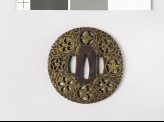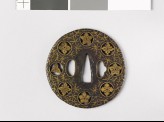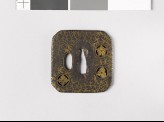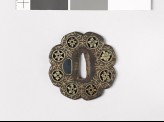The A. H. Church Collection of Japanese Sword-Guards (Tsuba)
An unpublished catalogue of the A. H. Church collection of Japanese sword-guards (tsuba) by Albert James Koop.
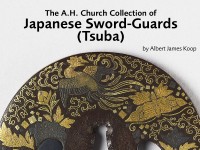
Flush inlay is a development of incrustation, and much of it seems to have been produced in quantities at an early date (15th century?) at Fushimi, a suburb of Kiōto where Hideyoshi, the great Taikō, erected the magnificent Juraku Palace, taking up his residence there in 1587. The names Yoshirō-zōgan and Fushimi-zōgan are now indifferently applied to this early inlay work (and its later imitations), the former term deriving from an oft-recurring signature of one Koike Yoshirō Naomasa Idzumi-no-kami of Fushimi, a stirrup-inlayer of 16th-century date who would appear to have founded a school of tsuba-inlayers.
After the downfall of Hideyoshi’s party in 1615, many of the Fushimi inlayers migrated to Kaga province at the invitation of the powerful Mayeda daimiō, and their subsequent history is continued under Group XXXII.
A well marked type included in the present group goes by the name of Mon-zukashi (“badge piercing”). In this the iron guard is symmetrically pierced with circular holes some half an inch wide, In which are inserted brass (less commonly copper) plugs, themselves either perforated and engraved, or else modelled or inlaid, to represent heraldic badges (mon); the rest of the ground is covered with flush inlay of brass, copper or silver, usually in conventional foliage diapers (water-weeds?). Signatures are very rare.
Yoshirō and Fushimi
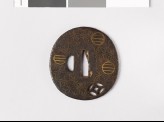 Tsuba with asanoha, or stylized hemp leaves (EAX.10136)
Tsuba with asanoha, or stylized hemp leaves (EAX.10136)
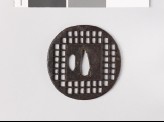 Tsuba with chequer pattern (EAX.10137)
Tsuba with chequer pattern (EAX.10137)
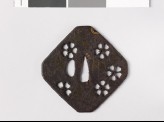 Tsuba with cherry blossoms and a cobweb (EAX.10138)
Tsuba with cherry blossoms and a cobweb (EAX.10138)
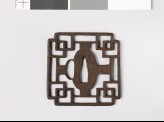 Tsuba with overlapping squares (EAX.10139)
Tsuba with overlapping squares (EAX.10139)
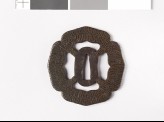 Tsuba with wave pattern (EAX.10140)
Tsuba with wave pattern (EAX.10140)
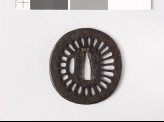 Tsuba with chrysanthemum florets and swastikas (EAX.10141)
Tsuba with chrysanthemum florets and swastikas (EAX.10141)
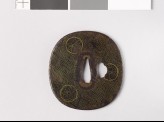 Tsuba with thunder-scroll pattern and flowers (EAX.10142)
Tsuba with thunder-scroll pattern and flowers (EAX.10142)
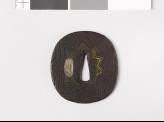 Tsuba with nine-pointed star (EAX.10143)
Tsuba with nine-pointed star (EAX.10143)
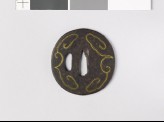 Tsuba with cloud forms (EAX.10144)
Tsuba with cloud forms (EAX.10144)
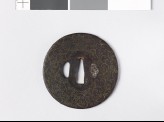 Round tsuba with scrolls and karigane, or flying geese (EAX.10145)
Round tsuba with scrolls and karigane, or flying geese (EAX.10145)
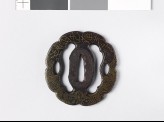 Double mokkō-shaped tsuba with zigzags and a Buddhist invocation (EAX.10146)
Double mokkō-shaped tsuba with zigzags and a Buddhist invocation (EAX.10146)
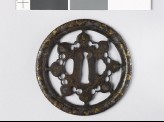 Round tsuba with karakusa, or scrolling plant pattern, interspersed with aoi, or hollyhock leaves (EAX.10147)
Round tsuba with karakusa, or scrolling plant pattern, interspersed with aoi, or hollyhock leaves (EAX.10147)
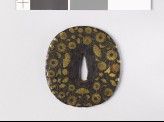 Tsuba with chrysanthemum sprays (EAX.10148)
Tsuba with chrysanthemum sprays (EAX.10148)
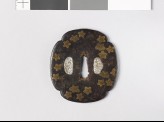 Mokkō-shaped tsuba with flowers and leaves (EAX.10149)
Mokkō-shaped tsuba with flowers and leaves (EAX.10149)
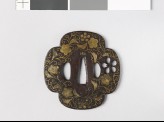 Mokkō-shaped tsuba with heraldic devices (EAX.10150)
Mokkō-shaped tsuba with heraldic devices (EAX.10150)
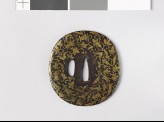 Lenticular tsuba with leaves and flowers (EAX.10151)
Lenticular tsuba with leaves and flowers (EAX.10151)
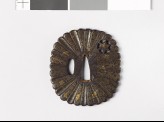 Tsuba with scrolling stems and heraldic cloves (EAX.10152)
Tsuba with scrolling stems and heraldic cloves (EAX.10152)
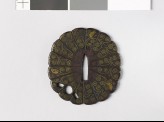 Tsuba with florets (EAX.10153)
Tsuba with florets (EAX.10153)
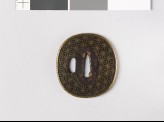 Tsuba with asanoha, or stylized hemp leaves (EAX.10154)
Tsuba with asanoha, or stylized hemp leaves (EAX.10154)
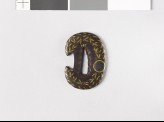 Hamidashi tsuba with leafy scrolls (EAX.10155)
Hamidashi tsuba with leafy scrolls (EAX.10155)
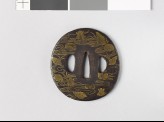 Tsuba with seashells amid water (EAX.10156)
Tsuba with seashells amid water (EAX.10156)
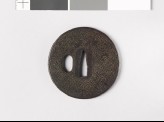 Round tsuba with swastikas (EAX.10157)
Round tsuba with swastikas (EAX.10157)
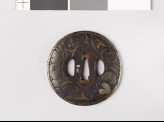 Tsuba with leaves and scrolling stems (EAX.10158)
Tsuba with leaves and scrolling stems (EAX.10158)
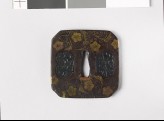 Square tsuba with karakusa, or scrolling floral pattern (EAX.10159)
Square tsuba with karakusa, or scrolling floral pattern (EAX.10159)
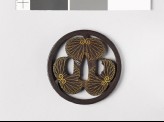 Round tsuba with three aoi, or hollyhock leaves (EAX.10160)
Round tsuba with three aoi, or hollyhock leaves (EAX.10160)
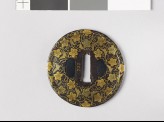 Round tsuba with karakusa, or scrolling floral pattern (EAX.10161)
Round tsuba with karakusa, or scrolling floral pattern (EAX.10161)
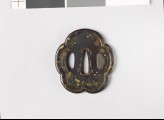 Lobed tsuba with asters and susuki grass (EAX.10162)
Lobed tsuba with asters and susuki grass (EAX.10162)
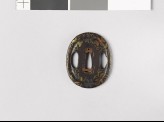 Tsuba with mon made from kiri, or paulownia leaves (EAX.10163)
Tsuba with mon made from kiri, or paulownia leaves (EAX.10163)
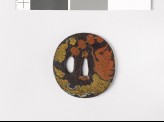 Round tsuba depicting Raiden, the god of thunder (EAX.10164)
Round tsuba depicting Raiden, the god of thunder (EAX.10164)
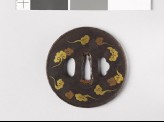 Round tsuba with clouds (EAX.10165)
Round tsuba with clouds (EAX.10165)
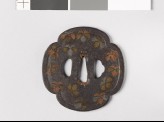 Mokkō-shaped tsuba with Cissus leaves (EAX.10166)
Mokkō-shaped tsuba with Cissus leaves (EAX.10166)
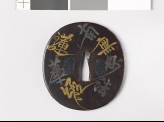 Tsuba with Buddhist invocation and a poem (EAX.10167)
Tsuba with Buddhist invocation and a poem (EAX.10167)
Mon-zukashi
Notice
Object information may not accurately reflect the actual contents of the original publication, since our online objects contain current information held in our collections database. Click on 'buy this publication' to purchase printed versions of our online publications, where available, or contact the Jameel Study Centre to arrange access to books on our collections that are now out of print.
© 2013 University of Oxford - Ashmolean Museum

